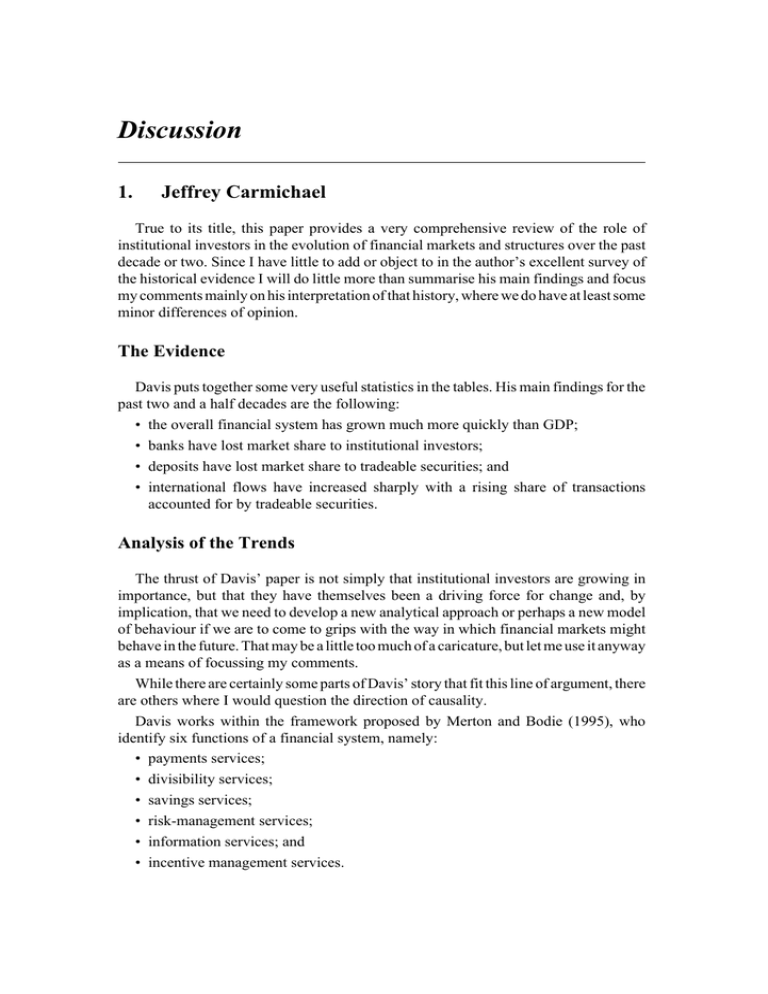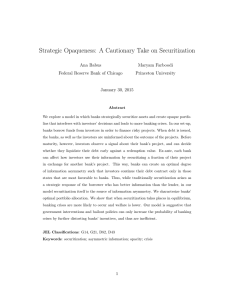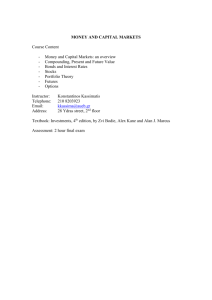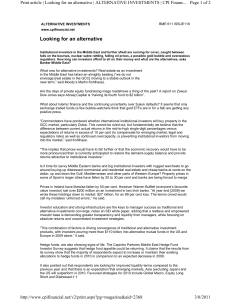Discussion 1. Jeffrey Carmichael
advertisement

100 Discussion Discussion 1. Jeffrey Carmichael True to its title, this paper provides a very comprehensive review of the role of institutional investors in the evolution of financial markets and structures over the past decade or two. Since I have little to add or object to in the author’s excellent survey of the historical evidence I will do little more than summarise his main findings and focus my comments mainly on his interpretation of that history, where we do have at least some minor differences of opinion. The Evidence Davis puts together some very useful statistics in the tables. His main findings for the past two and a half decades are the following: • the overall financial system has grown much more quickly than GDP; • banks have lost market share to institutional investors; • deposits have lost market share to tradeable securities; and • international flows have increased sharply with a rising share of transactions accounted for by tradeable securities. Analysis of the Trends The thrust of Davis’ paper is not simply that institutional investors are growing in importance, but that they have themselves been a driving force for change and, by implication, that we need to develop a new analytical approach or perhaps a new model of behaviour if we are to come to grips with the way in which financial markets might behave in the future. That may be a little too much of a caricature, but let me use it anyway as a means of focussing my comments. While there are certainly some parts of Davis’ story that fit this line of argument, there are others where I would question the direction of causality. Davis works within the framework proposed by Merton and Bodie (1995), who identify six functions of a financial system, namely: • payments services; • divisibility services; • savings services; • risk-management services; • information services; and • incentive management services. The Role of Institutional Investors in the Evolution of Financial Structure and Behaviour 101 Davis argues that institutional investors have increasingly come to fulfil these functions more efficiently than banks. This, coupled with the deterioration of bank quality due to loan-losses, and the regulatory burdens borne by banks, is put forward as the main explanation of the growing dominance of institutional investors over banks. My reservation is that there is too much exogeneity about the story – institutional investors gained market share because they worked out how to beat banks at their own game. The key question, in my view, is whether the shift in market structure reflects a shift in the market’s preferences away from banks as institutions or away from the functions performed by banks. Have banks been losing market share to institutional investors because of some basic difference in their nature or because of artificial institutional barriers imposed by government? If it is the former, then we may need to rethink our models of behaviour. If it is the latter, we may need to rethink our regulatory structures. From the perspective of the investor, the essential difference between the banking function and the institutional investor function lies in the nature of the promises being made. In the case of a bank, the promise is to repay a specified amount (principal plus interest) at a specified date in the future (often on demand) regardless of circumstances. An institutional investor, in most cases, promises to repay an amount defined by market circumstances at a specified date in the future: again, often on demand. Since both are capable of offering liquidity, payments services, savings services, and so on, the essential difference comes down to the capital guarantee. Whereas the bank promises to repay a fixed amount, the institutional investor promises a market-related repayment. There is thus a fundamental difference in the nature of the promise being made and the risk being borne by the investor. There are, of course, many hybrid variations in between these plain-vanilla extremes, including capital-guaranteed managed-fund products. Leaving aside the fact that institutions have merged across the functional boundary to some extent over the past 25 years, what is likely to bring about a shift in investor holdings from bank-type products to institutional-type products? There are three main candidates: • changes in investor preferences – for example, investors may have become wealthier, or less risk averse, or better informed, and so on; • regulatory restrictions on investors, for example, compulsory retirement savings; and • changes in relative prices, through changes in taxes, regulatory costs, technology, and the like. While there may be some grounds for arguing that investors have become better informed over time (especially due to technological innovations), the impact is unlikely to have been major. Similarly, while direct regulatory imposts on investors have been major in some countries such as Australia, the international trend appears to hold for countries that have not experienced the same imposts. This leaves price – or, from the institution’s perspective, cost – as the most likely driving force for the international changes in market share. Again there is some variation across countries, but there can be little dispute that the cost faced by institutional investors in providing the six basic financial functions has declined substantially relative to the cost of delivery faced by banks. In part this is due to technology and in part it is due to regulatory costs. Since regulatory costs are imposed on institutions rather than on 102 Discussion functions, it is not surprising that institutional investors have found themselves able to provide many traditional banking services more cheaply than banks, and that banks have sought to diversify into the functions traditionally performed by institutional investors and to do so through subsidiary vehicles not subject to the same regulatory costs faced by banks. A third factor influencing price (emphasised by Davis) is tax distortions, which many countries have used to encourage retirement savings; again these have served to advantage institutional investors relative to banks. My interpretation of these propositions is that there probably has been some natural shift in favour of financial products with an institutional-investor-type function due to technological advances – but that this has been amplified by a regulatory structure that has focussed on institutions rather than functions, by tax distortions that have done likewise and, in some cases, by direct regulatory restrictions on investors. Thus, if I were looking for something to quibble over, I might dispute with Davis: • the cause of the trends and whether or not they would have happened anyway as a natural consequence of technological innovation; and • whether it is more useful to analyse the trends in terms of financial functions rather than institutions. I would not dispute the need for analysts and policy makers alike to be aware of the implications of the changing patterns in finance. And, in this respect, Davis has hit the key points well: • institutional investors will continue to grow and will become increasingly competitive with banks in traditional areas of banking; • institutional investors will continue to expand cross-border trade in securities; • institutional growth may change financial structure (in particular, it may force changes in corporate governance); and • monetary and prudential management may become more difficult – volatility may increase, with trend-chasing and bubbles becoming more common. To these I would add that: • continuation of the current trend will put further pressure on the institutionally based regulatory structure; and • the potential for wholesale markets to ‘herd’ will put pressure on our traditional thinking about competition, liquidity and disclosure of risks to retail customers. 2. General Discussion The discussion focussed on the nature of competition between banks and institutional investors (or funds managers). In line with the author’s main thesis, it was suggested that the basic functions of the financial system remained more or less constant but that the means of performing those functions were changing. At issue was the relative efficiency of two broad approaches to the provision of finance, typified by banks and institutional investors: banks make loans on the basis of private information and shield their The Role of Institutional Investors in the Evolution of Financial Structure and Behaviour 103 depositors from the resultant credit risk, whereas institutional investors facilitate flows by means of publicly traded securities and pass on the risk to the investors. What has happened in recent decades is that the latter form of financing has substantially increased as a share of the total. The fact that the institutional investment sector was growing in all countries, despite widely differing tax and regulatory structures, suggested that some common causal factors were at work. One of these was likely to have been technological innovation, which had made it cheaper to access information and to compare investment products. This meant that the relative advantage that banks had had in assessing investment risks using private information had to some extent been eroded. Another factor highlighted in the discussion was the rising level of income and wealth. It was argued that long-term savings were a ‘superior’ good (that is, the demand for long-term savings would increase more-than-proportionately with income). Those savings tended to be held with institutional investors rather than banks since the wealthier long-term savers were more willing to accept risk in order to gain a higher expected return. Another contributor to growth of institutional investors was that these had traditionally been tax-advantaged in a number of countries, including Australia. This effect was reinforced by inflation-tax interactions which had strongly discouraged other forms of financial saving. It was commented that the growth of institutional investors, and the related trend of securitisation, seemed set to continue. There was still considerable scope for some types of bank loans, particularly in the consumer area, to be bundled into standard packages and sold off to investors. This was already happening to a considerable extent in the United States. A consequence of this was that loan originators from outside the banking sector could enter the market and compete with the banks in areas of their lending business, as for example was occurring in the home mortgage area. Even in small and medium-sized business loans, traditionally viewed as the core of banks’ lending activities, the experience of the United States showed that there was some scope for securitisation to occur. This was illustrated by the growth of private placement markets for the debt securities of small firms. Finally, it was suggested that institutional investors might take an increasing role in the payments system, as there was no necessary link between the provision of fixed-par deposit services and transaction facilities. The implications of these developments for the banks were discussed. A general theme was that the decline of banking did not necessarily mean the decline of banks. In particular it was argued that banks were not excluded from participating in the growing funds-management business. There was no reason that a funds-management subsidiary of a bank could not be just as successful as the independent funds-management firms. There were no regulatory impediments to this, and indeed bank funds-management subsidiaries had been increasing their share of this market in Australia in recent years. Another comment was that the decline in traditional bank business should not be exaggerated. It was true that bank balance sheets had been declining as a share of the financial system, but they were still growing relative to GDP, while a narrower measure of traditional banking, the volume of deposits, had been roughly stable as a ratio to GDP. These trends suggested that the decline in traditional banking activities was a relative and not an absolute phenomenon.








